Shrek Forever After Really Far Far Away
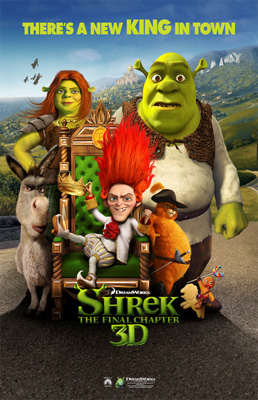
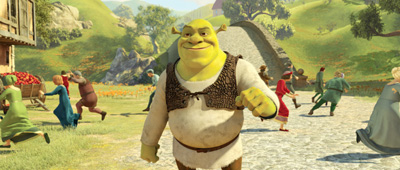
REALLY FAR FAR AWAY
One may think that the term "alternate reality" would mean the crew had carte blanche when it came to the look and design of the film, almost as if starting from scratch, but that was not entirely the case. "It was a real challenge when we set out to define the look of the film," says Mitchell. "We really wanted to give this film a different look while at the same time, be true to the world of Shrek." Adds producer Teresa Cheng, "We knew everyone would be curious to see the familiar and recognizable environments for Far Far Away transformed into an alternate universe."Mitchell, Shay and Cheng were inspired by the look that production designer Peter Zaslav created for the holiday special Shrek the Halls, which he had worked on with Cheng, and they turned to Zaslav and art director Max Boas for guidance. Shrek the Halls "was the first time I had seen Shrek and Fiona's house covered in snow," explains Mitchell. "It was familiar, but still very unique. I knew then that we would be able to pull off the alternate reality from a design perspective."
As a visual template, Zaslav and Boas started with the familiar shape language color palette established in the first three films. "Basically, the film starts out as a visual continuation of the previous Shrek films," explains Zaslav. The artists even amped up the colors just a notch in order to highlight the dramatic contrast when Shrek finds himself in the alternate reality. "It's even brighter, happier and more colorful than "Shrek 2" and "Shrek the Third"-that is, until Shrek signs his contract with Rumpelstiltskin and we catch a glimpse of the Far Far Away ruled by Rumpel."
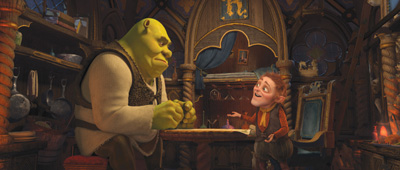 As soon as Shrek finds himself stranded in the new reality of Far Far Away, the look, tone and color of the film shift dramatically. A once lush, verdant landscape, Far Far Away has become a somewhat desolate, barren and dark wasteland, dominated by gold, greens and grays-inspired in part by the colors of the contract Shrek signs with Rumpel, especially the gold ink.
As soon as Shrek finds himself stranded in the new reality of Far Far Away, the look, tone and color of the film shift dramatically. A once lush, verdant landscape, Far Far Away has become a somewhat desolate, barren and dark wasteland, dominated by gold, greens and grays-inspired in part by the colors of the contract Shrek signs with Rumpel, especially the gold ink.Gold, as one would expect for a tale involving the fairy tale character that once promised a miller's daughter he could spin hay into a steady stream of twenty-four-karat thread, became an important touchstone for designing the alternate reality, ruled by Rumpel. "Gold has become a dominant visual theme associated with Rumpelstiltskin and that actually gets propagated to the entire environment," says Zaslav. "We've gotten used to the world of Shrek-all the green trees, the green lush grass. In the alternate reality, all that green gives way to more yellows and golds."
But this gold does not glitter; it is the gold of fall leaves and harvest time-the gold of fall, when things begin to decay, rather than the green spring of growth that typically animates the Shrek color scheme. This visual difference created a lot of opportunity for creativity for the filmmakers. "It's been a lot of fun turning the world upside down and playing up the contrast between the normal reality and watching Shrek navigate his way through this surreal world with swirling clouds and barren trees," says Boas.
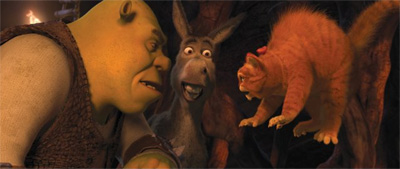 The darkness of the landscape reinforces, too, the initial bleakness of the story. Working this into the overall upbeat feeling of the Shrek franchise was challenging. "The world is going to be a little darker and a lot of this movie happens at night," explains Cheng. "One of our biggest challenges was to let the story unfold over twenty-four hours, [so that we] still have that 'ticking clock' feeling, but not live in darkness for too much of the film."
The darkness of the landscape reinforces, too, the initial bleakness of the story. Working this into the overall upbeat feeling of the Shrek franchise was challenging. "The world is going to be a little darker and a lot of this movie happens at night," explains Cheng. "One of our biggest challenges was to let the story unfold over twenty-four hours, [so that we] still have that 'ticking clock' feeling, but not live in darkness for too much of the film." As the characters, colors, and landscape begin to work against Shrek, creating a trapped feeling, a glimmer of hope still twinkles for the isolated ogre.Once he has re-befriended Donkey, he and his loyal companion find a clause in Rumpel's contract that provides Shrek with a twenty-four-hour window to set things right.
To contrast the dark tones of the film, the filmmakers created a number of new locations, environments and characters for the film that would liven things up, and bring some new opportunities for humor in the midst of this changed world. This led to an absurdist and decadent approach to Rumpelstiltskin and his army of witches, as well as his opulent, over-the-top palace.
But it is not just the locations that received a notable makeover. Everything from the characters in the film to the way the entire film will be screened was altered.
At the sheer mention of a "battle," one instantly imagines a visually stunning sequence and "Shrek Forever After" promises to deliver on that front. The first of the Shrek films to be shot in 3D stereoscopic vision, the visual effects team, led by Doug Cooper, had their work cut out for them. "3D is an equal partner in everything we do. We don't look at it as an afterthought," says Cooper. "We've given a lot of careful thought into the staging of our shots-designing them to take advantage of stereo."
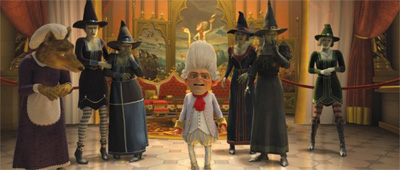 For the art department, that meant conceiving the world of Far Far Away from a 3D perspective. "The fact that we are doing this movie in 3D has complemented our attempt to expand the universe," says production designer Peter Zaslav. "We're literally building the sets out in all dimensions, something we've never done." Ultimately, technology serves the story and story is king.
For the art department, that meant conceiving the world of Far Far Away from a 3D perspective. "The fact that we are doing this movie in 3D has complemented our attempt to expand the universe," says production designer Peter Zaslav. "We're literally building the sets out in all dimensions, something we've never done." Ultimately, technology serves the story and story is king. The filmmakers were committed to staying true to their vision of telling an emotionally compelling story. "If we've done our jobs, you'll believe in this world because it is so well designed, art directed and executed," says producer Teresa Cheng. "You'll feel it rather than see it."
But the filmmakers did not want to sacrifice story and acting for the 3D spectacle. In approaching the more emotionally driven sequences in the script where the mental state of the characters needed to be clearly illustrated, the film's head of story Walt Dohrn and director Mike Mitchell would urge the story artists to begin by stripping away the more logistical "bells and whistles" production side of a giant CG 3D animated feature film and focus mainly on the basic, raw, minimal expression of character acting. "Not minimal as in simple," explains Dohrn, "but minimal in the sense that there is a pure heartfelt immediacy to the delicate hand-drawn line from the story artist that best represents the core of a character's feelings."
Even the subtlest shift of the position of an eyebrow can make a character go from expressing frustration to conveying regret. "There was always subtext to every scene, especially with a character like Shrek, who has a hard time expressing his feelings," say Dohrn. "In a scene where he appears to be expressing a frustrated anger, we knew deep down he's struggling with issues of self-worth. This would help dictate a more engaging, layered performance in our boards and, ultimately, in the final film."
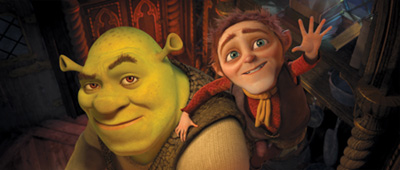
RE-IMAGINING THE INHABITANTS OF FAR FAR AWAY
The moment he signs the deal with Rumpel, Shrek finds himself more an ogre out of his swamp than a fish out of water. His reality torn to shreds, he is thrown into an alternate reality that at first, appears to be the same. The surroundings look and even feel familiar. At first Shrek thinks it's great, but soon discovers he's been tricked.The final straw of realization comes when he is attacked by Rumpel's henchwomen, the witches. Armed with smoke bombs, they capture Shrek and cart him off for a face-to-face meeting with Rumpel. Fortunately, Shrek sees a ray of hope in recognizing his waffle-loving best friend Donkey pulling the cart that cages him. This Donkey, however, looks the worse for wear and in bad need of a day at the groomer.
Taking well-known and beloved characters and throwing them into a new set of circumstances can be a challenging and daunting task for any filmmaker. Comments director Mitchell, "That's what made it so exciting to work on." Adds producer Shay, "Even though it was risky, Mike, Teresa and I wanted to completely uproot our beloved inhabitants of Far Far Away and place them in a drastically altered universe."
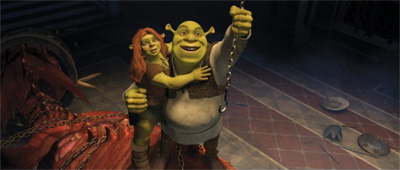 Because the characters in the world of Shrek are some of the most well thought-out and rich characters developed, they must pass the litmus test, meaning the core of the character, their "voice" and personality, rings true even in a completely foreign and new situation or story plot.
Because the characters in the world of Shrek are some of the most well thought-out and rich characters developed, they must pass the litmus test, meaning the core of the character, their "voice" and personality, rings true even in a completely foreign and new situation or story plot.While this was on the minds of the entire of crew, nobody knew this better than executive producer Aron Warner, who was at the producing helm of three previous installments. "The real secret is to ground stuff in the reality we already know," he explains. "Deep down, they are the same characters that audiences know and love and so long as they behave and act the same way they would under normal circumstances, they'll stay true to their core."
To illustrate his point, Warner refers to the scene where Shrek and Donkey finally meet in the new Far Far Away. Shrek has finally figured out what has happened. "Shrek is at his lowest," explains Warner. "He reconnects with Donkey and despite the alternate world, you see the core of their relationship is the same."
Acting the same in new environments or circumstances is one thing, but when it came to altering the looks of Donkey and Puss In Boots, the crew had to re-think their approach in the execution of the animation, rigging and modeling. "We had to really imagine how each character's life would be, how they would act, had they never met Shrek," explains Mitchell.
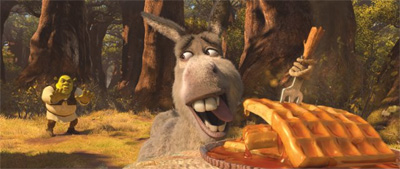 Re-envisioning Donkey presented a whole new set of obstacles for the crew. "It's a delicate line because you want to be true to the character's personality," explains Jason Reisig, head of character animation. To maintain their personalities the filmmakers kept the trademark enthusiasm of Donkey and Puss In Boots' cleverness and sly delivery intact. The end result is watching how that enthusiasm plays out while Donkey is under the employ of the witches and as Puss lives the life of a pampered fat-cat.
Re-envisioning Donkey presented a whole new set of obstacles for the crew. "It's a delicate line because you want to be true to the character's personality," explains Jason Reisig, head of character animation. To maintain their personalities the filmmakers kept the trademark enthusiasm of Donkey and Puss In Boots' cleverness and sly delivery intact. The end result is watching how that enthusiasm plays out while Donkey is under the employ of the witches and as Puss lives the life of a pampered fat-cat. For the visual effects team, however, the new looks of Donkey and Puss brought forth a new set of obstacles. "Donkey presented a big challenge as his fur is a bit longer now," explains Oliver Finkelde, head of character effects. "Since the fur is longer, we have to make sure the skin [of the model] is not overlapping so we either go back to the animation department and ask them to adjust, or we actually deform the skin so there is a gap between, say, the leg and the chest." Due to the additional amount of volume and fur on Puss, the crew faced similar challenges in the modeling and rigging of the feline. Of course, those obstacles also paved the way for more than a few humorous moments. "Puss is just this big, fat, pampered cat and he is hysterical to look at," says Eddie Murphy. "Donkey actually has to help him get his back cleaned in one scene and that is worth the price of admission just to see that."
Shrek Forever After - Princess Fiona & The Visual Effects
www.girl.com.au/shrekforever-princess-fiona-effects.htm
Shrek Forever After
www.girl.com.au/shrek-forever-after.htm
Rumpelstiltskin Shrek Forever After
www.girl.com.au/rumpelstiltskin-shrek-forever-after.htm
Shrek Forever After Really Far Far Away
www.girl.com.au/shrek-forever-after-far-far-away.htm
MORE





